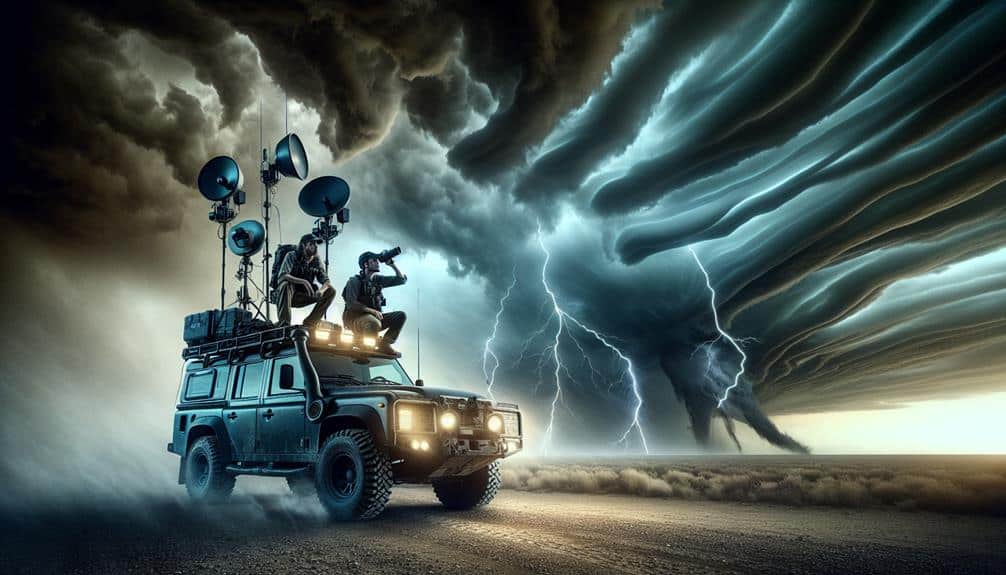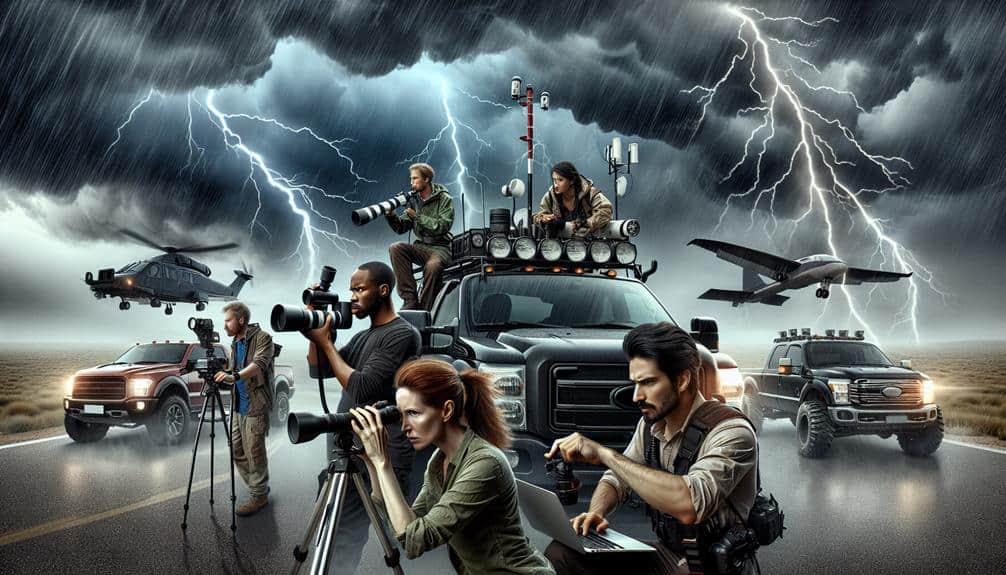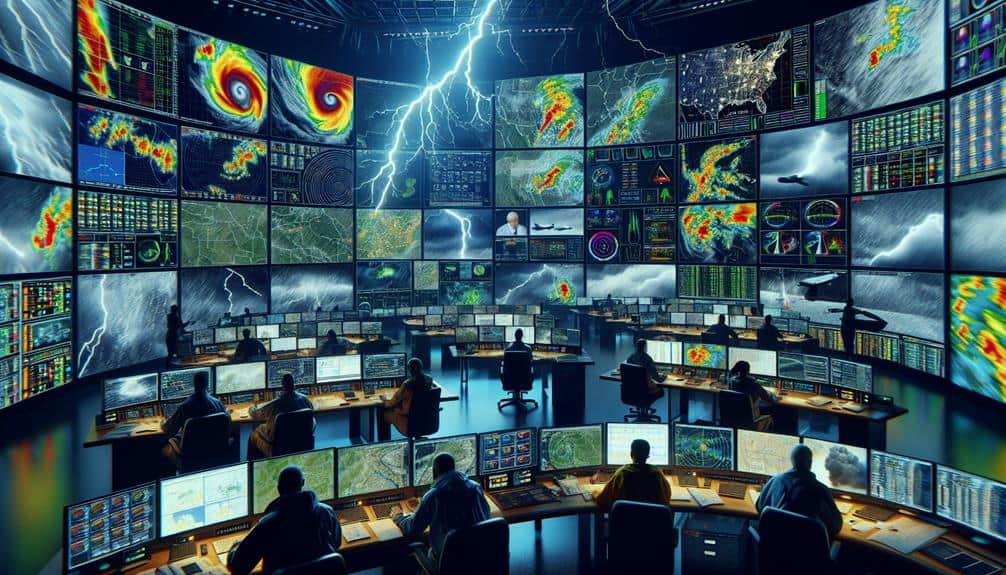To become successful storm spotters, we need to join reputable networks, master advanced meteorological tools, and follow strict safety protocols. Being part of a respected network enhances our situational awareness and provides access to shared meteorological data, aiding precise storm tracking. Mastering tools like radar, satellite imagery, and numerical weather prediction models allows us to identify severe weather phenomena and anticipate storm development. Strict adherence to safety measures and established communication protocols ensures our real-time situational awareness and quick decision-making in the field. By integrating these essentials, we can greatly enhance storm spotter effectiveness and operational safety. Discover more by staying on course.
Key Points
- Join a reputable network to gain access to shared meteorological data and real-time storm tracking information.
- Master meteorological tools such as radar interpretation and satellite imagery to enhance your storm forecasting abilities.
- Follow strict safety measures and use established communication protocols to ensure team safety during storm-spotting missions.
- Utilize GPS and two-way radios for real-time data interpretation and improved situational awareness in the field.
Join a Reputable Network
Why is joining a respected network of storm spotters crucial for accurate and timely weather data collection? When we engage in storm chasing, we need precise and real-time data to track extreme weather events effectively. By joining a respected network, we gain access to a collaborative platform where data from multiple sources coalesces, enhancing our situational awareness.
Within these networks, we can leverage shared meteorological data, which is critical for precise storm tracking. The aggregated information from other spotters in real-time provides a detailed view of storm development, movement, and potential impact zones. This collaboration ensures that our observations are validated and corroborated by other experienced storm spotters, increasing the reliability of our reports.
Moreover, respected networks often have direct communication channels with meteorological agencies, guaranteeing our data contributes to broader weather models. This integration is crucial for timely warnings and forecasts that protect communities from extreme weather events. By participating in a network, we enhance our capabilities and guarantee that our storm chasing efforts are both safe and scientifically valuable.
Ensuring our data is part of a larger, credible pool not only amplifies our impact but also supports the collective goal of understanding and mitigating severe weather phenomena.
Master Meteorological Tools
Mastering meteorological tools is crucial for accurately predicting storm behavior and guaranteeing our safety during storm chasing expeditions. To achieve this, we need to become skilled in weather forecasting and radar interpretation. These skills allow us to anticipate storm development and track their progression with precision.
Weather forecasting relies on analyzing atmospheric data, including temperature, humidity, wind speed, and pressure trends. By interpreting these metrics, we can predict storm formation and movement. Tools like numerical weather prediction models and satellite imagery provide critical real-time data, empowering us to make informed decisions.
Radar interpretation is another essential skill for storm spotters. Doppler radar systems measure precipitation intensity and motion, helping us identify severe weather phenomena such as tornadoes, hail, and heavy rainfall. Understanding radar signatures, like hook echoes and velocity couplets, enables us to detect rotation and potential tornado genesis.
Integrating these tools into our storm-spotting practice enhances our situational awareness and decision-making capabilities. By mastering meteorological tools, we not only enhance our ability to predict storm behavior but also guarantee we're making data-driven choices that maximize our safety and freedom during storm chasing adventures.
Prioritize Safety and Communication
While our expertise in meteorological tools equips us to predict storm behavior accurately, maintaining our safety and effective communication are crucial during storm-spotting missions. Implementing strict safety measures and adhering to established communication protocols are pivotal. We can't afford to underestimate the volatile nature of storms. Properly calibrated equipment, situational awareness, and a firm grasp of escape routes are non-negotiable elements of our safety strategy.
Training sessions provide us with the knowledge to navigate hazardous environments, but it's our field experience that solidifies these skills. In the field, real-time data interpretation and quick decision-making are essential. We rely on robust communication protocols to relay important information. This ensures that every team member is aware of current conditions and potential threats. Utilizing tools like GPS, two-way radios, and mobile apps can significantly improve our situational awareness and coordination.
Our commitment to safety extends beyond ourselves. By following these protocols, we contribute to the broader network of storm spotters, aiding public safety agencies in issuing timely warnings. Prioritizing safety and communication isn't just about our freedom to pursue our passion; it's about guaranteeing we can continue to do so responsibly and effectively.
Frequently Asked Questions
What Qualifications Do I Need to Become a Storm Spotter?
When it rains, it pours. We need a background in meteorology, but a degree isn't mandatory. Storm chasing experience and knowledge of weather patterns are essential. Skillful navigation and data collection techniques enhance our effectiveness as storm spotters.
How Can I Get Involved in Storm Spotter Community Events?
To get involved in storm spotter community events, we should prioritize community engagement and networking. We can also explore volunteer opportunities and outreach programs. By participating, we enhance our skills and contribute to public safety effectively.
Are There Any Online Courses Available for Storm Spotting?
You won't believe the abundance of online resources available! We can gain certification through extensive training programs covering advanced storm spotting techniques. These courses offer the freedom to study at our own pace, ensuring we're fully prepared.
How Do I Report My Findings to Weather Authorities?
We should report our findings using established communication methods learned in training. Guarantee data collection is accurate and follows safety protocols. Use designated channels like spotter networks, apps, or direct lines to weather authorities for efficient reporting.
What Equipment Is Essential for Storm Spotting?
Imagine a sailor in a storm without a compass. For effective storm spotting, our storm spotting gear includes a reliable anemometer, GPS, and a high-resolution camera. These necessary equipment pieces guarantee accurate data collection and personal safety.


